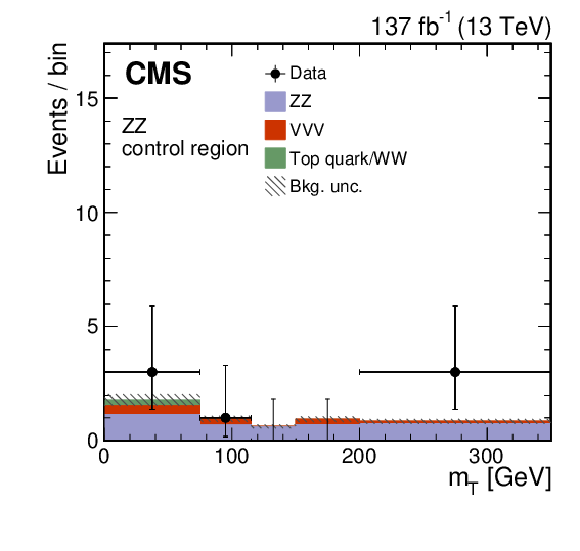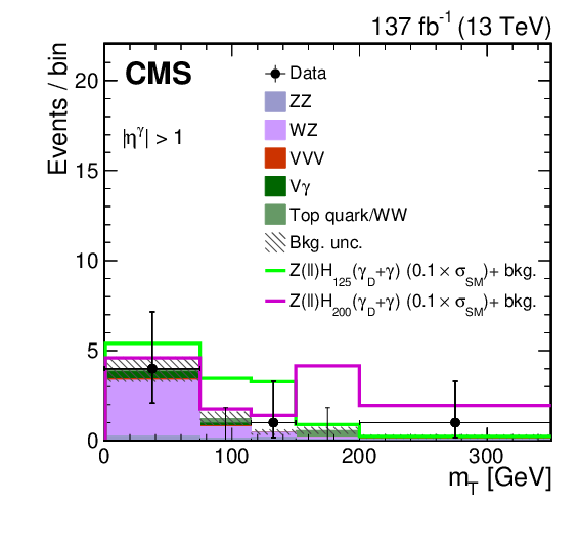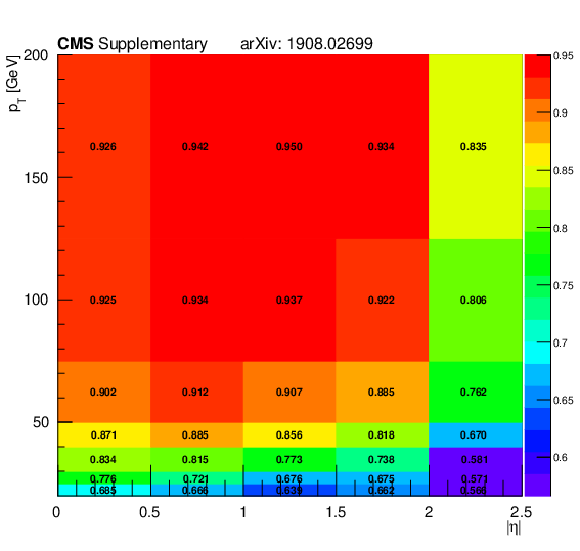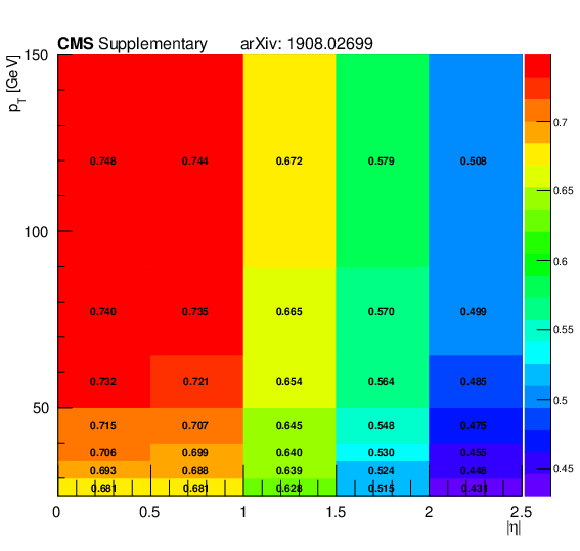

Compact Muon Solenoid
LHC, CERN
| CMS-EXO-19-007 ; CERN-EP-2019-159 | ||
| Search for dark photons in decays of Higgs bosons produced in association with Z bosons in proton-proton collisions at $\sqrt{s} = $ 13 TeV | ||
| CMS Collaboration | ||
| 7 August 2019 | ||
| JHEP 10 (2019) 139 | ||
| Abstract: A search is presented for a Higgs boson that is produced in association with a Z boson and that decays to an undetected particle together with an isolated photon. The search is performed by the CMS Collaboration at the Large Hadron Collider using a data set corresponding to an integrated luminosity of 137 fb$^{-1}$ recorded at a center-of-mass energy of 13 TeV. No significant excess of events above the expectation from the standard model background is found. The results are interpreted in the context of a theoretical model in which the undetected particle is a massless dark photon. An upper limit is set on the product of the cross section for associated Higgs and Z boson production and the branching fraction for such a Higgs boson decay, as a function of the Higgs boson mass. For a mass of 125 GeV, assuming the standard model production cross section, this corresponds to an observed (expected) upper limit on this branching fraction of 4.6 (3.6)% at 95% confidence level. These are the first limits on Higgs boson decays to final states that include an undetected massless dark photon. | ||
| Links: e-print arXiv:1908.02699 [hep-ex] (PDF) ; CDS record ; inSPIRE record ; HepData record ; CADI line (restricted) ; | ||
| Figures & Tables | Summary | Additional Figures & Tables | References | CMS Publications |
|---|
| Figures | |

png pdf |
Figure 1:
A Feynman diagram for the production of the $\mathrm{Z} (\to \ell \ell) \mathrm{H} (\to \gamma \gamma _\mathrm {D})$ final state. |

png pdf |
Figure 2:
The $ {m_{\mathrm {T}}} $ distributions for the e$\mu $, WZ, and ZZ control regions after the simultaneous fit to data in the signal and control regions. Statistical and systematic uncertainties in the expected background yields are represented by the hatched band. Vertical bars represent data statistical uncertainties, while horizontal bars represent the bin widths. |

png pdf |
Figure 2-a:
The $ {m_{\mathrm {T}}} $ distributions for the e$\mu $ control region after the simultaneous fit to data in the signal and control regions. Statistical and systematic uncertainties in the expected background yields are represented by the hatched band. Vertical bars represent data statistical uncertainties, while horizontal bars represent the bin widths. |

png pdf |
Figure 2-b:
The $ {m_{\mathrm {T}}} $ distributions for the WZ control region after the simultaneous fit to data in the signal and control regions. Statistical and systematic uncertainties in the expected background yields are represented by the hatched band. Vertical bars represent data statistical uncertainties, while horizontal bars represent the bin widths. |

png pdf |
Figure 2-c:
The $ {m_{\mathrm {T}}} $ distributions for the ZZ control region after the simultaneous fit to data in the signal and control regions. Statistical and systematic uncertainties in the expected background yields are represented by the hatched band. Vertical bars represent data statistical uncertainties, while horizontal bars represent the bin widths. |

png pdf |
Figure 3:
The $ {m_{\mathrm {T}}} $ distributions in the signal region for two $m_{\mathrm{H}}$ values for events with $ {{| \eta ^\gamma |}} <$ 1 (left) and $ {{| \eta ^\gamma |}} > $ 1 (right), after the fit to data. The signal size corresponds to 0.1$ \sigma _{\mathrm{Z} \mathrm{H}}$ for both values of $m_{\mathrm{H}}$ shown. The signal processes are stacked on top of all backgrounds. Statistical and systematic uncertainties in the expected background yields are represented by the hatched band. Vertical bars represent data statistical uncertainties, while horizontal bars represent the bin widths. |

png pdf |
Figure 3-a:
The $ {m_{\mathrm {T}}} $ distributions in the signal region for two $m_{\mathrm{H}}$ values for events with $ {{| \eta ^\gamma |}} <$ 1, after the fit to data. The signal size corresponds to 0.1$ \sigma _{\mathrm{Z} \mathrm{H}}$ for both values of $m_{\mathrm{H}}$ shown. The signal processes are stacked on top of all backgrounds. Statistical and systematic uncertainties in the expected background yields are represented by the hatched band. Vertical bars represent data statistical uncertainties, while horizontal bars represent the bin widths. |

png pdf |
Figure 3-b:
The $ {m_{\mathrm {T}}} $ distributions in the signal region for two $m_{\mathrm{H}}$ values for events with $ {{| \eta ^\gamma |}} > $ 1, after the fit to data. The signal size corresponds to 0.1$ \sigma _{\mathrm{Z} \mathrm{H}}$ for both values of $m_{\mathrm{H}}$ shown. The signal processes are stacked on top of all backgrounds. Statistical and systematic uncertainties in the expected background yields are represented by the hatched band. Vertical bars represent data statistical uncertainties, while horizontal bars represent the bin widths. |

png pdf |
Figure 4:
Expected and observed upper limits at 95% CL on the product of $\sigma _{\mathrm{Z} \mathrm{H}}$ and $\mathcal {B}(\mathrm{H} \to \text {invisible}+\gamma)$ as a function of $m_{\mathrm{H}}$. The dot-dashed line shows the predicted signal corresponding to 0.1$ \sigma _{\mathrm{Z} \mathrm{H}}$. |
| Tables | |

png pdf |
Table 1:
Summary of the selection criteria and the main background processes. |

png pdf |
Table 2:
Observed yields, background estimates after the fit to data, and signal predictions after the event selection. The signal size corresponds to 0.1$ \sigma _{\mathrm{Z} \mathrm{H}}$ for all three $m_{\mathrm{H}}$ values shown. The combined statistical and systematic uncertainties are reported. The values in parentheses for the signal processes correspond to the products of acceptance and selection efficiency for $\mathrm{Z} \to \ell \ell $ events. |
| Summary |
| A search is presented for a Higgs boson produced in association with a Z boson and decaying to an undetected particle together with an isolated photon. The analysis is based on a data set recorded by the CMS experiment in 2016-18 at a center-of-mass energy of 13 TeV, corresponding to an integrated luminosity of 137 fb$^{-1}$ . No significant excess of events above the expectation from standard model backgrounds is found. The results are used to place limits on the product of the cross section for associated ZH production and the branching fraction for such decays of the Higgs boson, in the context of a theoretical model where the undetected particle is a massless dark photon. The observed and expected upper limits at 95% confidence level at $m_{\mathrm{H}} = $ 125 GeV on $\mathcal{B}(\mathrm{H} \to \text{invisible}+\gamma)$, assuming standard model ZH associated production, are 4.6 and 3.6%, respectively. Allowing for deviations from standard model ZH production, the product of $\sigma_{\mathrm{Z}\mathrm{H}}$ and $\mathcal{B}(\mathrm{H} \to \text{invisible}+\gamma)$ is excluded above $\sim$40 to $\sim$4 fb, for $m_{\mathrm{H}}$ ranging from 125 to 300 GeV. These are the first limits on Higgs boson decays to final states that include an undetected massless dark photon. |
| Additional Figures | |

png pdf |
Additional Figure 1:
Muon identification and isolation efficiency as a function of $ {| \eta |}$ and $ {p_{\mathrm {T}}} $. |

png pdf |
Additional Figure 2:
Electron identification and isolation efficiency as a function of $ {| \eta |}$ and $ {p_{\mathrm {T}}} $. |

png pdf |
Additional Figure 3:
Photon identification and isolation efficiency as a function of $ {| \eta |}$ and $ {p_{\mathrm {T}}} $. |

png pdf |
Additional Figure 4:
Covariance matrix for all bins used in the analysis. There are 45 bins in total, 15 for every data-taking year. For every year, the first bin corresponds to events in the $ {\mathrm {e}}\mu $ control region, the following five bins correspond to events with $ {{| \eta ^\gamma |}} < $ 1 in the signal region, the next five bins correspond to events with $ {{| \eta ^\gamma |}} > $ 1 in the signal region, the next two bins correspond to events in the WZ control region, and finally the last two bins correspond to events in the ZZ control region. |
| Additional Tables | |

png pdf |
Additional Table 1:
Expected yields for different processes after several selection stages. The preselection requires two leptons and at least one photon with $ {p_{\mathrm {T}}} $ larger than 25, 20, and 25 GeV, respectively; in addition the dilepton $ {p_{\mathrm {T}}} $ must be larger than 60 GeV, and the $ {{p_{\mathrm {T}}} ^\text {miss}} $ larger than 70 GeV. The signal prediction corresponds to $\mathcal {B}({\mathrm {H}} \to \text {invisible}+\gamma) = $ 10% assuming the standard model ZH cross section at $m_{{\mathrm {H}}} = $ 125 GeV. |
| References | ||||
| 1 | ATLAS Collaboration | Observation of a new particle in the search for the standard model Higgs boson with the ATLAS detector at the LHC | PLB 716 (2012) 1 | 1207.7214 |
| 2 | CMS Collaboration | Observation of a new boson at a mass of 125 GeV with the CMS experiment at the LHC | PLB 716 (2012) 30 | CMS-HIG-12-028 1207.7235 |
| 3 | CMS Collaboration | Observation of a new boson with mass near 125 GeV in pp collisions at $ \sqrt{s} = $ 7 and 8 TeV | JHEP 06 (2013) 081 | CMS-HIG-12-036 1303.4571 |
| 4 | D. Ghosh et al. | Looking for an invisible Higgs signal at the LHC | PLB 725 (2013) 344 | 1211.7015 |
| 5 | S. P. Martin and J. D. Wells | Motivation and detectability of an invisibly decaying Higgs boson at the Fermilab Tevatron | PRD 60 (1999) 035006 | hep-ph/9903259 |
| 6 | Y. Bai, P. Draper, and J. Shelton | Measuring the invisible Higgs width at the 7 and 8 TeV LHC | JHEP 07 (2012) 192 | 1112.4496 |
| 7 | D. Curtin et. al. | Exotic decays of the 125 GeV Higgs boson | PRD 90 (2014) 075004 | 1312.4992 |
| 8 | ATLAS and CMS Collaborations | Combined measurement of the Higgs boson mass in $ pp $ collisions at $ \sqrt{s}= $ 7 and 8 TeV with the ATLAS and CMS experiments | PRL 114 (2015) 191803 | 1503.07589 |
| 9 | CMS Collaboration | Measurements of properties of the Higgs boson decaying into the four-lepton final state in pp collisions at $ \sqrt{s}= $ 13 TeV | JHEP 11 (2017) 047 | CMS-HIG-16-041 1706.09936 |
| 10 | ATLAS and CMS Collaborations | Measurements of the Higgs boson production and decay rates and constraints on its couplings from a combined ATLAS and CMS analysis of the LHC pp collision data at $ \sqrt{s}= $ 7 and 8 TeV | JHEP 08 (2016) 045 | 1606.02266 |
| 11 | CMS Collaboration | Combined measurements of Higgs boson couplings in proton-proton collisions at $ \sqrt{s}= $ 13 TeV | EPJC 79 (2019) 421 | CMS-HIG-17-031 1809.10733 |
| 12 | A. Djouadi and M. Drees | Higgs boson decays into light gravitinos | PLB 407 (1997) 243 | hep-ph/9703452 |
| 13 | C. Petersson, A. Romagnoni, and R. Torre | Higgs decay with monophoton + $ {\not\!\!E_T} $ signature from low scale supersymmetry breaking | JHEP 10 (2012) 016 | 1203.4563 |
| 14 | E. Gabrielli and M. Raidal | Exponentially spread dynamical Yukawa couplings from nonperturbative chiral symmetry breaking in the dark sector | PRD 89 (2014) 015008 | 1310.1090 |
| 15 | E. Gabrielli, M. Heikinheimo, B. Mele, and M. Raidal | Dark photons and resonant monophoton signatures in Higgs boson decays at the LHC | PRD 90 (2014) 055032 | 1405.5196 |
| 16 | S. Biswas, E. Gabrielli, M. Heikinheimo, and B. Mele | Dark-photon searches via Higgs-boson production at the LHC | PRD 93 (2016) 093011 | 1603.01377 |
| 17 | S. Biswas, E. Gabrielli, M. Heikinheimo, and B. Mele | Searching for massless dark-photons at the LHC via Higgs boson production | in Proceedings, 2017 European Physical Society Conference on High Energy Physics (EPS-HEP 2017), Venice, Italy, 2017 | |
| 18 | CMS Collaboration | Search for the decay of a Higgs boson in the $ \ell\ell\gamma $ channel in proton-proton collisions at $ \sqrt{s} = $ 13 TeV | JHEP 11 (2018) 152 | CMS-HIG-17-007 1806.05996 |
| 19 | ATLAS Collaboration | Searches for the $ Z\gamma $ decay mode of the Higgs boson and for new high-mass resonances in $ pp $ collisions at $ \sqrt{s} = $ 13 TeV with the ATLAS detector | JHEP 10 (2017) 112 | 1708.00212 |
| 20 | CMS Collaboration | Search for exotic decays of a Higgs boson into undetectable particles and one or more photons | PLB 753 (2016) 363 | CMS-HIG-14-025 1507.00359 |
| 21 | CMS Collaboration | The CMS Experiment at the CERN LHC | JINST 3 (2008) S08004 | CMS-00-001 |
| 22 | CMS Collaboration | The CMS trigger system | JINST 12 (2017) P01020 | CMS-TRG-12-001 1609.02366 |
| 23 | S. Frixione and B. R. Webber | Matching NLO QCD computations and parton shower simulations | JHEP 06 (2002) 029 | hep-ph/0204244 |
| 24 | P. Nason | A new method for combining NLO QCD with shower Monte Carlo algorithms | JHEP 11 (2004) 040 | hep-ph/0409146 |
| 25 | S. Frixione, P. Nason, and C. Oleari | Matching NLO QCD computations with parton shower simulations: the POWHEG method | JHEP 11 (2007) 070 | 0709.2092 |
| 26 | S. Alioli, P. Nason, C. Oleari, and E. Re | NLO vector-boson production matched with shower in POWHEG | JHEP 07 (2008) 060 | 0805.4802 |
| 27 | S. Alioli, P. Nason, C. Oleari, and E. Re | A general framework for implementing NLO calculations in shower Monte Carlo programs: the POWHEG BOX | JHEP 06 (2010) 043 | 1002.2581 |
| 28 | LHC Higgs Cross Section Working Group | Handbook of LHC Higgs cross sections: 3. Higgs properties | 1307.1347 | |
| 29 | LHC Higgs Cross Section Working Group | Handbook of LHC Higgs cross sections: 4. deciphering the nature of the Higgs sector | 1610.07922 | |
| 30 | J. Alwall et al. | The automated computation of tree-level and next-to-leading order differential cross sections, and their matching to parton shower simulations | JHEP 07 (2014) 079 | 1405.0301 |
| 31 | J. Alwall et al. | MadGraph 5: going beyond | JHEP 06 (2011) 128 | 1106.0522 |
| 32 | R. Frederix and S. Frixione | Merging meets matching in MC@NLO | JHEP 12 (2012) 061 | 1209.6215 |
| 33 | NNPDF Collaboration | Parton distributions for the LHC Run II | JHEP 04 (2015) 040 | 1410.8849 |
| 34 | NNPDF Collaboration | Parton distributions from high-precision collider data | EPJC 77 (2017) 663 | 1706.00428 |
| 35 | T. Sjostrand, S. Mrenna, and P. Z. Skands | A brief introduction to PYTHIA 8.1 | CPC 178 (2008) 852 | 0710.3820 |
| 36 | P. Skands, S. Carrazza, and J. Rojo | Tuning PYTHIA 8.1: the Monash 2013 tune | EPJC 74 (2014) 3024 | 1404.5630 |
| 37 | CMS Collaboration | Event generator tunes obtained from underlying event and multiparton scattering measurements | EPJC 76 (2016) 155 | CMS-GEN-14-001 1512.00815 |
| 38 | CMS Collaboration | Extraction and validation of a new set of CMS PYTHIA8 tunes from underlying-event measurements | Submitted to EPJC | CMS-GEN-17-001 1903.12179 |
| 39 | GEANT4 Collaboration | GEANT4 --- a simulation toolkit | NIMA 506 (2003) 250 | |
| 40 | CMS Collaboration | Particle-flow reconstruction and global event description with the CMS detector | JINST 12 (2017) P10003 | CMS-PRF-14-001 1706.04965 |
| 41 | M. Cacciari, G. P. Salam, and G. Soyez | The anti-$ {k_{\mathrm{T}}} $ jet clustering algorithm | JHEP 04 (2008) 063 | 0802.1189 |
| 42 | CMS Collaboration | Jet energy scale and resolution in the CMS experiment in pp collisions at 8 TeV | JINST 12 (2017) P02014 | CMS-JME-13-004 1607.03663 |
| 43 | CMS Collaboration | Pileup removal algorithms | CMS-PAS-JME-14-001 | CMS-PAS-JME-14-001 |
| 44 | M. Cacciari, G. P. Salam, and G. Soyez | FastJet user manual | EPJC 72 (2012) 1896 | 1111.6097 |
| 45 | CMS Collaboration | Identification of heavy-flavour jets with the CMS detector in pp collisions at 13 TeV | JINST 13 (2018) P05011 | CMS-BTV-16-002 1712.07158 |
| 46 | CMS Collaboration | Performance of the CMS missing transverse momentum reconstruction in $ {\mathrm{p}}{\mathrm{p}} $ data at $ \sqrt{s} = $ 8 TeV | JINST 10 (2015) P02006 | CMS-JME-13-003 1411.0511 |
| 47 | CMS Collaboration | Performance of electron reconstruction and selection with the CMS detector in proton-proton collisions at $ \sqrt{s} = $ 8 TeV | JINST 10 (2015) P06005 | CMS-EGM-13-001 1502.02701 |
| 48 | CMS Collaboration | Performance of the CMS muon detector and muon reconstruction with proton-proton collisions at $ \sqrt{s} = $ 13 TeV | JINST 13 (2018) P06015 | CMS-MUO-16-001 1804.04528 |
| 49 | CMS Collaboration | Measurements of properties of the Higgs boson decaying to a W boson pair in pp collisions at $ \sqrt{s}= $ 13 TeV | PLB 791 (2019) 96 | CMS-HIG-16-042 1806.05246 |
| 50 | CMS Collaboration | Performance of photon reconstruction and identification with the CMS Detector in proton-proton collisions at $ \sqrt{s} = $ 8 TeV | JINST 10 (2015) P08010 | CMS-EGM-14-001 1502.02702 |
| 51 | Particle Data Group Collaboration | Review of particle physics | PRD 98 (2018) 030001 | |
| 52 | CMS Collaboration | Search for new physics in events with a leptonically decaying Z boson and a large transverse momentum imbalance in proton-proton collisions at $ \sqrt{s} = $ 13 TeV | EPJC 78 (2018) 291 | CMS-EXO-16-052 1711.00431 |
| 53 | The ATLAS Collaboration, The CMS Collaboration, The LHC Higgs Combination Group | Procedure for the LHC Higgs boson search combination in Summer 2011 | CMS-NOTE-2011-005 | |
| 54 | CMS Collaboration | CMS luminosity measurement for the 2016 data-taking period | CMS-PAS-LUM-15-001 | CMS-PAS-LUM-15-001 |
| 55 | CMS Collaboration | CMS luminosity measurement for the 2017 data-taking period at $ \sqrt{s} = $ 13 TeV | CMS-PAS-LUM-17-004 | CMS-PAS-LUM-17-004 |
| 56 | CMS Collaboration | CMS luminosity measurement for the 2018 data-taking period at $ \sqrt{s} = $ 13 TeV | CMS-PAS-LUM-18-002 | CMS-PAS-LUM-18-002 |
| 57 | ATLAS Collaboration | Measurement of the inelastic proton-proton cross section at $ \sqrt{s} = $ 13 TeV with the ATLAS detector at the LHC | PRL 117 (2016) 182002 | 1606.02625 |
| 58 | CMS Collaboration | Measurement of the inelastic proton-proton cross section at $ \sqrt{s}= $ 13 TeV | JHEP 07 (2018) 161 | CMS-FSQ-15-005 1802.02613 |
| 59 | S. Catani, D. de Florian, M. Grazzini, and P. Nason | Soft gluon resummation for Higgs boson production at hadron colliders | JHEP 07 (2003) 028 | hep-ph/0306211 |
| 60 | M. Cacciari et al. | The $ \mathrm{t\bar{t}} $ cross section at $ 1.8 $ TeV and $ 1.96 $ TeV: a study of the systematics due to parton densities and scale dependence | JHEP 04 (2004) 068 | hep-ph/0303085 |
| 61 | J. Butterworth et al. | PDF4LHC recommendations for LHC run II | JPG 43 (2016) 023001 | 1510.03865 |
| 62 | A. L. Read | Presentation of search results: the $ CL_s $ technique | JPG 28 (2002) 2693 | |
| 63 | T. Junk | Confidence level computation for combining searches with small statistics | NIMA 434 (1999) 435 | hep-ex/9902006 |
| 64 | G. Cowan, K. Cranmer, E. Gross, and O. Vitells | Asymptotic formulae for likelihood-based tests of new physics | EPJC 71 (2011) 1554 | 1007.1727 |

|
Compact Muon Solenoid LHC, CERN |

|

|

|

|

|

|